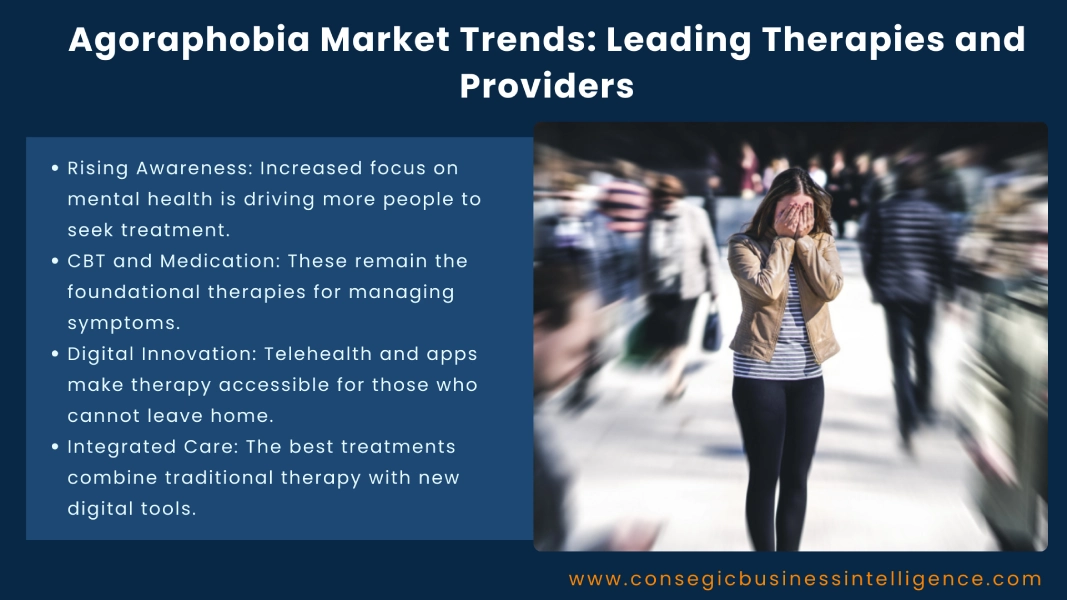Agoraphobia Market Trends: Leading Therapies and Providers
Agoraphobia is a complex anxiety disorder characterized by the fear of situations where escape may be difficult or help unavailable, often leading to avoidance of crowded places, public transportation, or even leaving home. Once considered a niche mental health condition, agoraphobia is gaining attention as awareness of mental health grows globally. Rising prevalence, improved diagnostic tools, and increasing demand for accessible treatments are fueling the growth of the agoraphobia treatment market. The market is being shaped by a combination of evolving therapies and innovative providers. Traditional approaches such as cognitive-behavioral therapy (CBT) and pharmacological treatments remain vital, while digital therapeutics, telehealth, and app-based solutions are redefining access to care.

Below are the key trends, therapies, and providers driving the agoraphobia market forward.
- Cognitive-Behavioral Therapy (CBT) as a Cornerstone
CBT remains the gold-standard psychological treatment for agoraphobia. By helping patients identify and challenge irrational fears, CBT reduces avoidance behavior and improves coping strategies. The rise of online therapy platforms such as BetterHelp and Talkspace has made CBT more accessible, especially for patients hesitant to attend in-person sessions. This shift highlights how traditional therapy is evolving through digital delivery.
- Exposure Therapy Gaining Momentum
Exposure therapy, a subtype of CBT, is gaining prominence as clinicians refine structured approaches to gradually confront feared situations. Providers such as NOCD and specialty anxiety clinics are increasingly offering guided exposure sessions through digital platforms. Virtual reality (VR)-based exposure therapy is also emerging, allowing patients to safely face triggering environments in controlled settings, a trend that is gaining traction in both research and practice.
- Pharmacological Treatments and Expanding Drug Portfolios
Medications continue to play a critical role in agoraphobia management, especially for moderate to severe cases. Selective serotonin reuptake inhibitors (SSRIs) such as sertraline and paroxetine, as well as benzodiazepines for short-term relief, remain widely prescribed. Pharmaceutical giants like Pfizer, GlaxoSmithKline (GSK), and Eli Lilly contribute to this segment with antidepressants and anti-anxiety medications. The push toward next-generation drugs with fewer side effects is shaping future treatment options.
- Digital Therapeutics Redefining Access
The rise of digital health has opened new pathways for treating agoraphobia. App-based CBT programs, AI-driven chatbots, and remote monitoring tools are offering patients more control over their care. Companies like Pear Therapeutics and Happify Health are developing digital therapeutics designed to complement or replace traditional therapy. These tools not only reduce barriers to care but also provide scalable solutions for underserved populations.
- Telepsychiatry and Online Therapy Platforms
Telehealth has become a mainstream trend, particularly since the pandemic, and it continues to influence the agoraphobia treatment market. Platforms like Amwell and MDLIVE connect patients to licensed therapists and psychiatrists from their homes, reducing the need for travel, an especially important factor for those with severe agoraphobia. Furthermore, Telepsychiatry ensures that patients can access care consistently, regardless of geographic limitations.
- Integration of Virtual Reality (VR) in Therapy
VR is increasingly being integrated into mental health treatments as an effective tool for exposure therapy. Startups such as Oxford VR and Psious have developed platforms that immerse patients in virtual environments, helping them gradually face situations like crowded trains or shopping centers. This trend is expected to grow as VR hardware becomes more affordable and therapy providers incorporate these tools into standard care.
- Growing Role of Group and Peer-Support Programs
While individual therapy dominates, group therapy and peer-support programs are expanding as supplementary treatments. Organizations like the Anxiety & Depression Association of America (ADAA) and online peer networks provide patients with a sense of community, reducing isolation. These programs are increasingly being integrated with professional care to create holistic support systems for agoraphobia patients.
- Insurance Coverage and Government Initiatives
Market growth is also being influenced by better insurance coverage for mental health treatments. In many regions, policies are being updated to cover digital therapies and telehealth sessions. Governments and nonprofit organizations are funding awareness campaigns and community-based programs, ensuring more patients seek timely help. This supportive environment is encouraging providers to expand their offerings and invest in innovative therapies.
- Personalized and AI-Driven Care Models
Artificial intelligence is starting to shape mental health treatment, including agoraphobia care. AI tools analyze patient data to personalize therapy plans, monitor progress, and provide real-time feedback. Companies such as Wysa and Woebot Health are pioneering AI-driven mental health assistants, which are being adopted as adjunct tools in treatment plans. Personalized care supported by data-driven insights is emerging as a future direction for the market.
- Expanding Global Awareness and Destigmatization
Awareness campaigns and destigmatization efforts are driving more individuals to seek treatment for agoraphobia. Providers across the globe are adapting their services to meet rising demand, particularly in regions where mental health care has historically been underutilized. This cultural shift, combined with technological advancements, is fueling market expansion at a steady pace.
Conclusion
The agoraphobia treatment market is evolving through a mix of traditional and modern approaches. CBT and exposure therapy remain central, while medications from companies like Pfizer, GSK, and Eli Lilly continue to provide pharmacological support. At the same time, digital therapeutics, telepsychiatry platforms, and VR-based therapies are redefining access and personalization. Providers such as BetterHelp, Talkspace, Amwell, Oxford VR, and Pear Therapeutics are at the forefront of these innovations, helping to make care more effective and accessible. As awareness of mental health grows and technology continues to advance, the agoraphobia market is poised for significant expansion.
